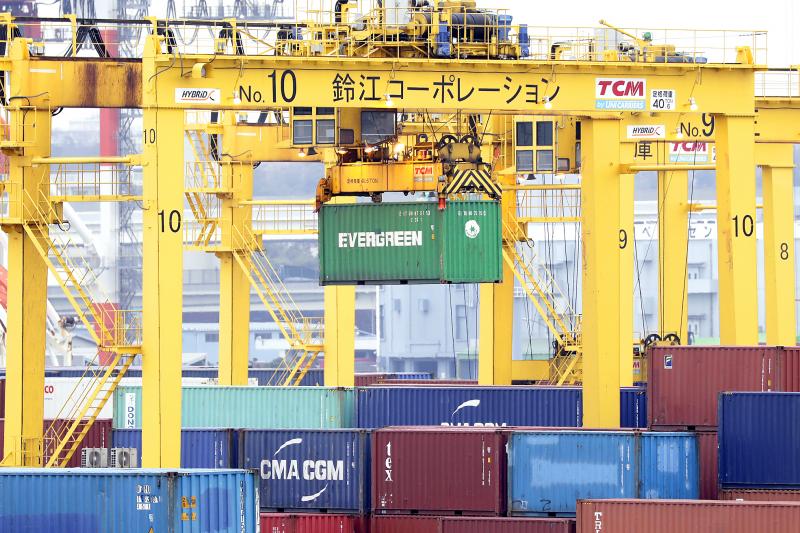Evergreen Marine Corp (長榮海運) on Tuesday said it expects a rebound in its cargo volume in the third quarter after facing an up to 20 percent plunge in the first half of the year due to the COVID-19 pandemic.
However, as uncertainties remain in the fourth quarter, the company’s annual cargo volume might fall 15 percent year-on-year for the whole of this year, the nation’s largest cargo shipper said.
While the pandemic has decelerated economic activity worldwide and weakened demand in the global container shipping market, Evergreen saw demand pick up earlier this month and has received more orders for next month and August, company chairman Anchor Chang (張正鏞) told a news briefing in Taipei.

Photo: Bloomberg
Summer is traditionally the cargo shipping industry’s peak season, as many suppliers transport their goods for clients ahead of product launches.
“The cargo volume in the third quarter is likely to be flat from last year, but it would be a decent performance considering the effects of the pandemic,” Chang said. “It is difficult to see annual growth in volume this year, as global trade declines and consumption slows due to lockdown measures.”
The world’s three major container shipping alliances — the Alliance, 2M Alliance and Ocean Alliance — have reduced their capacity amid the outbreak to address oversupply in the industry, which helps shippers maintain load factors and curb declines in freight rates, Evergreen executive vice president Patrick Wei (魏維德) said.
A reduction in capacity would have a mixed effect on shippers’ financial performance, as it would lead to a drop in revenue while saving their operational costs, such as fuel and labor costs, Wei said.
Most shippers in the past few months have performed maintenance on their idle vessels, while Evergreen has equipped its idle vessels with scrubbers to reduce emissions and meet new International Maritime Organization regulations, Wei said.
“It is questionable whether most shippers would continue trimming capacity in the fourth quarter when the cargo demand recovers, but if all shippers return to full capacity, the oversupply issue would emerge again,” he said.
For Evergreen, revenue generated from the Asia-Europe route and the Asia-US route accounts for 65 percent of its total revenue.
A second wave of COVID-19 in the West could complicate fourth-quarter visibility for cargo volume, he said.
The shipper has reported no infections among its crews, saying that it bars them from disembarking when arriving at any port and does not allow families aboard.
Evergreen also routinely takes its crews’ temperatures and orders them to self-isolate before boarding, it said.
The company added that it has extended contracts with crew members who could not return home due to border restrictions.
“This is a challenging year for shippers,” Chang said.
Evergreen reported a net loss of NT$441.3 million (US$14.89 million) for the first quarter, after revenue fell 4.86 percent year-on-year to NT$43.48 billion.
Net loss per share was NT$0.09 in the first quarter, compared with earnings per share of NT$0.12 a year earlier.

Taiwan Semiconductor Manufacturing Co (TSMC, 台積電) last week recorded an increase in the number of shareholders to the highest in almost eight months, despite its share price falling 3.38 percent from the previous week, Taiwan Stock Exchange data released on Saturday showed. As of Friday, TSMC had 1.88 million shareholders, the most since the week of April 25 and an increase of 31,870 from the previous week, the data showed. The number of shareholders jumped despite a drop of NT$50 (US$1.59), or 3.38 percent, in TSMC’s share price from a week earlier to NT$1,430, as investors took profits from their earlier gains

AI TALENT: No financial details were released about the deal, in which top Groq executives, including its CEO, would join Nvidia to help advance the technology Nvidia Corp has agreed to a licensing deal with artificial intelligence (AI) start-up Groq, furthering its investments in companies connected to the AI boom and gaining the right to add a new type of technology to its products. The world’s largest publicly traded company has paid for the right to use Groq’s technology and is to integrate its chip design into future products. Some of the start-up’s executives are leaving to join Nvidia to help with that effort, the companies said. Groq would continue as an independent company with a new chief executive, it said on Wednesday in a post on its Web

CHINA RIVAL: The chips are positioned to compete with Nvidia’s Hopper and Blackwell products and would enable clusters connecting more than 100,000 chips Moore Threads Technology Co (摩爾線程) introduced a new generation of chips aimed at reducing artificial intelligence (AI) developers’ dependence on Nvidia Corp’s hardware, just weeks after pulling off one of the most successful Chinese initial public offerings (IPOs) in years. “These products will significantly enhance world-class computing speed and capabilities that all developers aspire to,” Moore Threads CEO Zhang Jianzhong (張建中), a former Nvidia executive, said on Saturday at a company event in Beijing. “We hope they can meet the needs of more developers in China so that you no longer need to wait for advanced foreign products.” Chinese chipmakers are in

POLICY REVERSAL: The decision to allow sales of Nvidia’s H200 chips to China came after years of tightening controls and has drawn objections among some Republicans US House Republicans are calling for arms-sale-style congressional oversight of artificial intelligence (AI) chip exports as US President Donald Trump’s administration moves to approve licenses for Nvidia Corp to ship its H200 processor to China. US Representative Brian Mast, the Republican chairman of the US House Committee on Foreign Affairs, which oversees export controls, on Friday introduced a bill dubbed the AI Overwatch Act that would require the US Congress to be notified of AI chips sales to adversaries. Any processors equal to or higher in capabilities than Nvidia’s H20 would be subject to oversight, the draft bill says. Lawmakers would have